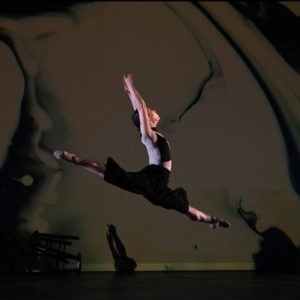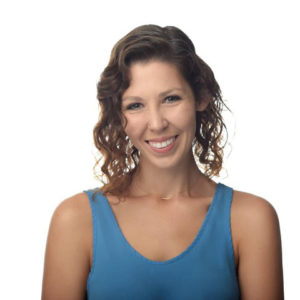“The lessons learned in the dance classroom inform our behaviors as we interact with others; how we provide service, how we treat our bodies, how we communicate, and how we collaborate.”
APPROACH TO CLASS:
I have always loved puzzles. I love finding new and interesting ways to solve problems. What I find most exciting about teaching is that each class is a new puzzle and I use this approach to help my students to explore their technique. By laying down a foundation of basic anatomy and kinesiology, I teach my students to safely solve technical puzzles as they apply to the execution of movements in their bodies. This approach allows me to create a positive learning environment where students can explore and celebrate their differences without fear of judgment.
AGES TAUGHT:
Both Youth & Adult Students
LEVELS TAUGHT:
Elizabeth’s Joy of Motion classes are Level II – IV and Intro, but she teaches students who are new to dance through professional dancers.
STYLES TAUGHT:
At Joy of Motion, Elizabeth teaches Ballet and Scottish Highland Dance. She also teaches modern outside of Joy of Motion.

INFLUENCES:
Jose Limon, Nacho Duato, and Jiri Kylian.
EDUCATION/CERTIFICATIONS:
SOCIAL MEDIA:
![]() Instagram: @elizwatson
Instagram: @elizwatson
Schedule:
Get to Know Elizabeth!
Who have you danced with?
How did you become a dancer?
At around the age of 5, I have a very vivid memory of attending an Irish Festival in my hometown with my family and being absolutely captivated by the dancers. My mom likes to recall that I was basically climbing on the stage because I couldn’t get close enough. My family being Scottish, and my uncle being a bagpiper, they shortly after enrolled me in Scottish Highland Dance classes (close enough). I competed nationally and internationally and was working towards pursuing championship levels. I was told that if I wanted to be the best, I would have to start taking ballet classes to refine my technique. I took my very first ballet class at age 12 and fell immediately in love. Because I was at such a pivotal age developmentally, I remember very clearly learning the technique from the ground up and asking all the “hows” and “whys” of the training. I remember taking a physics class in high school and REALLY understanding how the mechanics of dancing worked and how it clarified movement for me. I love imparting that level of understanding onto my students and having them view movement more holistically, rather than arbitrarily.
What is your teaching philosophy or your approach to teaching?
I have always loved puzzles. I love finding new and interesting ways to solve problems. What I find most exciting about teaching is that each class is a new puzzle. How can I get my students from A to B in one count? In one class? In one semester? How is A and B different from class to class, discipline to discipline? Sometimes, the answer comes right away. In other cases, it is an exhausting process of discovery by trial and error. Either way, solving these puzzles for my students and watching them experience that “lightbulb” moment for themselves makes even the most frustrating puzzle well worth the effort.
I have adopted this “puzzle” approach to the exploration and experience of dance technique. I want dancing to make sense to my students and my aim is to help them understand how pieces of technique sequence together to make a complete movement; dancing. Through my experience and training in Pilates, I am able to focus a great deal of attention on anatomical placement and injury prevention. By laying down a foundation of basic anatomy and kinesiology in my classes, I teach my students to safely solve technical puzzles as they apply to their personal structural differences. I encourage my students to evaluate and acknowledge these differences as I believe that a better understanding of movement comes from an understanding of one’s personal anatomy. I continually strive to communicate not just how a movement is executed, but why it is done in a particular way. I find that approaching technique in this way not only has clarified and refined my teaching but has also encouraged my students to question what they are learning so that they may better apply the information as it pertains to themselves as individuals.
By allowing my students to appreciate their unique differences, I am able to create a positive learning environment where students feel they can explore different and challenging movements without fear of judgment. I plan each of my classes to have either a theme or a through-line; I find this helps give both myself and my students a sense of cognitive continuity to each class while still allowing some wiggle room to give more time when needed. I structure my classes to include both familiar and new exercises so that students may feel confident in refining what they already know and comfortable in trying what they do not yet know. Giving regular and frequent feedback is important to me and by providing students the opportunity to repeat exercises, I am able to address potential problem areas quickly and specifically so as to prevent injuries from occurring or developing. Having a strong relationship with the accompanists in my classes has been essential in addressing the qualitative and rhythmic needs of the students while instilling an appreciation for live music.
What I believe to be one of the most wonderful and rewarding gifts that come with studying dance is that dancing permeates into how we conduct ourselves outside of the studio. The lessons learned in the dance classroom inform our behaviors as we interact with others; how we provide service, how we treat our bodies, how we communicate, and how we collaborate. As an educator, my goal is to instill these positive values in my students and encourage a life-long commitment to dancing that continues long after a student leaves the studio, and maybe even to love puzzles, too.








